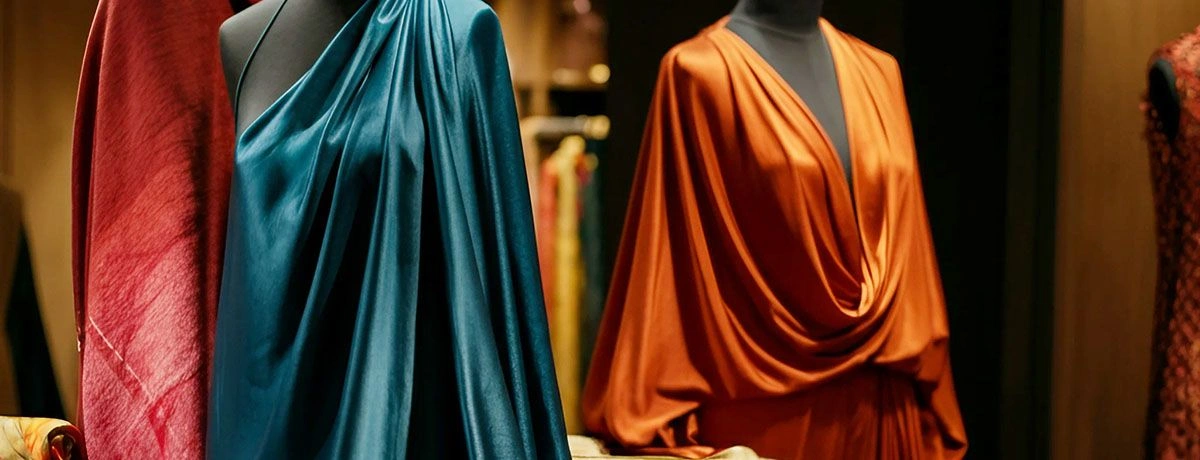Fabric Drape & Fit Guide

When it comes to garment and home textile manufacturing, drape and fit are the often overlooked heroes that can make or break a product. Whether you’re making a flowing evening dress or a set of luxurious curtains, selecting the best fabric can enhance the drape and fit, taking your designs to the next level and consumer satisfaction to the roof.
This guide covers the basics of drape and fit, including what they mean, what affects them and practical tips for textile selection, design and production. By the end of this guide you’ll have a roadmap to choosing your fabric to meet both design and consumer expectations.
What is Fabric Drape and Fit?
In Manufacturing
Fabric drape is how a fabric hangs or flows when used in a garment or textile product. Fit is how a fabric conforms to the intended shape, whether it’s a body or furniture. Both drape and fit affect the visual, comfort and functionality of the product.
For garment manufacturers, drape of the fabric determines how stylish and flowing the piece looks, while fit determines how it wears. Fabric weight and drape are closely related but have a nuanced relationship that impacts fabric performance in garment making. For home textile manufacturers, the drape of curtains, bedsheets or upholstery is key to aesthetics, while fit is key to functionality and purpose.
Consumer Perception
Consumer perception is all about drape and fit. Stiff fabrics on an evening dress can get poor reviews, while soft flowing fabrics are associated with elegance and quality. The same applies to home textiles – products that don’t hang well or don’t fit well reflect poorly on the overall quality.
Fabric Drape
What is Fabric Drape
Fabric drape is how freely or stiffly a piece of fabric falls. It’s determined by the fabric’s properties, making it either soft and flowing or stiff and structured. A fluid drape allows the fabric to conform to the body's shape while effectively holding pleats, highlighting its versatility in design.
Drape Characteristics
-
Soft Drape: Lightweight fabrics like chiffon, silk, or rayon are examples of flowy fabric that flow softly, perfect for evening dresses or decorative curtains.
-
Moderate Drape: Fabrics with moderate drape fit close to the body without clinging, offering a balance between flowy and crisp characteristics, making them suitable for versatile garments.
-
Stiff Drape: Heavier fabrics like denim or canvas hold their shape, ideal for jackets or upholstery.
What Affects Fabric Drape
Several things affect fabric drape:
-
Fiber Type: Natural fibers like silk or cotton drape better than synthetic fibers because of their flexibility.
-
Fabric Weight: Lighter fabrics with good drape flow smoothly, while heavier fabrics are stiffer and less suitable for creating a flowing look.
-
Weave and Knit: The pattern and method of weaving or knitting determines drape – for example satin weaves create a smoother, more flowing drape than plain weaves.
Fabric Fit
What is Fit in Textiles
Fit is how well a fabric conforms to the shape or dimensions it’s intended for – whether that’s a person, a piece of furniture or another product.
What Affects Fit
-
Stretch: Fabrics with elasticity like spandex or jersey fit better to movement and creates a snug fit.
-
Recovery: A fabric’s ability to recover to its original shape after stretching means durability and long term use.
-
Grainline: Cutting the fabric along the grainline ensures the best fit and prevents distortion when used.
Choosing the Right Fabrics
In Manufacturing
For drape and fit to be optimal, the fabric selection must match the end use of the product – whether it’s a flowing dress or tailored upholstery.
-
Garment Manufacturing: Dresses, skirts and blouses need soft drape fabrics, structured pieces like blazers need stiffer fabrics.
-
Home Textiles: Flowing curtains need soft drape fabrics, and selecting the right curtain fabric based on design needs is crucial. Tightly fitted upholstery needs high recovery fabrics and suitable upholstery fabric. Additionally, the variety of drapery fabric styles and colors available for home decor projects can enhance the overall aesthetic.
Case Studies in Upholstery Fabric
-
A women’s clothing brand increased sales by 30% by replacing stiff polyester fabrics with soft draping silk blends in their evening wear collection.
-
A home textile manufacturer reduced returns by 20% by using more stretchable fabrics in their fitted sheets, improving snugness and usability.
Testing and Measuring Drape and Fit
Industry Standards
Fabric drape can be measured scientifically using methods like the fabric drape test or drape coefficient which measures how the fabric hangs when held from a fixed point. Calculating how many yards of fabric are needed is essential for making curtains, as it ensures you have the right amount for the desired length and pattern. Fit can be measured through 3D body scanning or tailored measurements.
Quality Control
Regular testing ensures drape and fit in finished products. Use quality control checks like stretch recovery tests and fit trials to maintain high standards and reduce returns.
Drape and Fit in Production
Design
Designers need to consider fabric behaviour during the design process. For example, fabrics that hang straight down from the body are ideal for tailored garments, while those that hold pleats effectively can enhance drape and structure. Additionally, fabrics with a voluminous drape are perfect for special occasions, providing a dramatic and standout effect.
Cutting and Sewing
Cutting along the grainline and high quality stitching ensures the finished product has the desired drape and fit.
Textile Technology Future
Drape and fit is an ongoing process. Future innovations like smart fabrics with adaptive properties will change how fabric conforms and flows. For now, knowing these basics gives you an edge in the market.
For professionals looking to fine tune their fabric selection [Brand Name] has a range of high drape fabrics to help you take your product to the next level. Explore now to see what’s possible for your collection.
